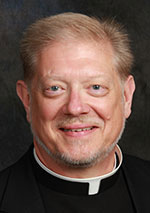That All May Be One / Fr. Rick Ginther
‘Festival of Faiths’ allows us to embrace diversity in our midst
 It’s good to be back from my July hiatus from this column! It’s always good to have a “sabbath rest”!
It’s good to be back from my July hiatus from this column! It’s always good to have a “sabbath rest”!
The “Festival of Faiths” is coming again. The seventh annual celebration will be held on Sunday, Sept. 22, on the Veterans’ Memorial Plaza in Indianapolis. It begins at 1 p.m. and goes until 5 p.m.
For the past six years, folks have allowed themselves an encounter with the religious diversity in central Indiana.
It is one thing to encounter it. It is another to embrace religious diversity.
“Embracing Religious Diversity” is the theme of this year’s festival. But what is “embracing”?
One way to respond to this question is: How does our own religion respond to, and relate to, other religions? This would be our denominational response.
Another way to respond to this question would be more personal: How do we celebrate the diverse religious landscape in central Indiana?
As Roman Catholics, we have a checkered history in embracing in friendship other religions. Our history is littered with examples of intolerance, even violence.
This changed dramatically at the Second Vatican Council (1962-65). Spurred on by the “signs of the times,” the Church saw World War II as a tipping point for humanity. Too many people died because of ethnic and religious hatreds. This was not the way of Christ.
Through the lens of the Gospel, St. Paul’s writings and Old Testament texts, biblical scholars came to propose updated interpretations.
This led to a greater taking to heart the notion “that all may be one” (Jn 17:21), such as recognizing the faith of Abraham as a common foundation for Jews, Christians and Muslims, and the faith of the Canaanite woman—a non-Jew— begging Jesus to cure her daughter of a demon (Mt 15:21-28), to cite just a few examples.
From the council came four important documents to guide the Church in embracing religious diversity. They include:
-
Nov. 21, 1964: “Decree on Ecumenism” (“Unitatis Redintegratio”), and the “Dogmatic Constitution on the Church” (“Lumen Gentium”);
-
Oct. 28, 1965: “Declaration on the Relationship of the Church with Non-Christian Religions” (“Nostrae Aetate”);
-
Dec. 7, 1965: “Declaration on Religious Freedom” (“Dignitatis Humanae”).
These documents made it abundantly clear that the Church sees a relation between it and all people seeking God through faith.
If related, then we are to seek out that which is common to us in religious observance and its expression in daily living. We are to see the truth held therein. We are to build relationships, and we are to rejoice in this.
This is not a denial of humanity’s salvation in Christ Jesus, and not a step which would have all religions equated or rolled into one (a notion known as “syncretism”). It is a seeking of the Spirit and where the Spirit blows. We are to rejoice in this.
Embracing the reality of religious diversity should not threaten our faith. It should help us to grow in our faith, even as we learn, ponder, admire and question the faith expressed in the diversity of religions which share our common home.
Come to the Veterans’ Memorial Plaza for the Festival of Faiths. Visit the archdiocese’s booths. See how the universal Church embraces diversity. And allow yourself to celebrate the diversity in our midst.
(Father Rick Ginther is director of the archdiocesan Office of Ecumenism and Interreligious Affairs. He is pastor of Our Lady of Lourdes Parish, Indianapolis.) †
 It’s good to be back from my July hiatus from this column! It’s always good to have a “sabbath rest”!
It’s good to be back from my July hiatus from this column! It’s always good to have a “sabbath rest”!